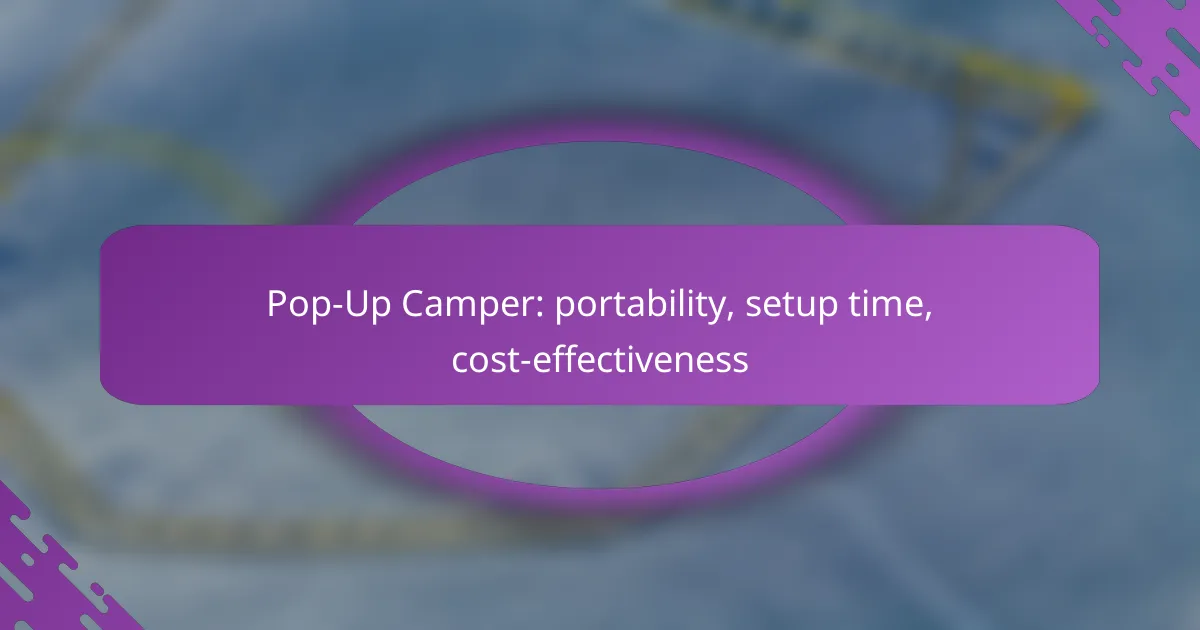Pop-up campers are an excellent choice for outdoor enthusiasts seeking portability, cost-effectiveness, and quick setup times. With setup typically taking just 10 to 30 minutes, they provide a hassle-free camping experience, making them ideal for families and individuals eager to explore nature. Additionally, their price range in Canada, from CAD 5,000 to CAD 20,000, offers options for various budgets and preferences.

What are the benefits of pop-up campers in Canada?
Pop-up campers offer several advantages for outdoor enthusiasts in Canada, including portability, cost-effectiveness, and quick setup times. These features make them an appealing choice for families and individuals looking to explore the great outdoors without the hassle of traditional RVs.
Portability for easy travel
Pop-up campers are designed to be lightweight and compact, making them easy to tow with a variety of vehicles, including smaller SUVs and trucks. Their folded size allows for simple storage and transport, fitting into standard parking spaces and driveways.
When considering a pop-up camper, check the towing capacity of your vehicle to ensure compatibility. Most models weigh between 1,000 to 3,000 pounds, allowing for flexibility in travel options.
Cost-effective camping solution
Pop-up campers are generally more affordable than traditional travel trailers or motorhomes, with prices often ranging from a few thousand to around twenty thousand Canadian dollars. This lower cost makes them accessible for families and individuals who want to enjoy camping without breaking the bank.
Additionally, pop-up campers typically have lower maintenance costs and better fuel efficiency compared to larger RVs, further enhancing their cost-effectiveness for frequent campers.
Quick setup and takedown
Setting up a pop-up camper usually takes just a few minutes, allowing campers to spend more time enjoying their surroundings. Most models feature simple mechanisms for raising the roof and extending the sides, making the process straightforward.
To streamline setup, familiarize yourself with the camper’s features and practice the process at home before your trip. This preparation can help you avoid common pitfalls, such as forgetting essential steps or tools during setup.

How do you set up a pop-up camper?
Setting up a pop-up camper involves a few straightforward steps that ensure a smooth camping experience. The process typically takes around 10 to 30 minutes, depending on your familiarity with the camper and the campsite conditions.
Step 1: Prepare the campsite
Before setting up your pop-up camper, choose a level area free of debris and sharp objects. Clear the ground of rocks, sticks, and other potential hazards to protect the camper’s underside and ensure stability.
It’s also wise to check local regulations regarding camping in the area. Some sites may have specific rules about where you can park or set up your camper, so be sure to comply with any posted guidelines.
Step 2: Unfold the camper
Once the campsite is prepared, begin by releasing any latches or locks that secure the pop-up camper. Carefully unfold the camper, extending it fully to create the living space.
Ensure that the canvas is not caught in any moving parts during this process. A common mistake is to rush this step, which can lead to tears or damage to the fabric.
Step 3: Secure the supports
After unfolding the camper, locate the support poles and set them in place to stabilize the structure. Most pop-up campers have a specific order for securing these supports, so refer to your owner’s manual for guidance.
Double-check that all supports are firmly in place and that the camper is level. This step is crucial for comfort and safety during your stay, as an unstable camper can lead to issues such as leaking or difficulty in opening and closing the camper later on.

What is the average cost of pop-up campers in Canada?
The average cost of pop-up campers in Canada typically ranges from CAD 5,000 to CAD 20,000, depending on the model, features, and condition. Newer models with advanced amenities tend to be on the higher end of this spectrum, while older or more basic models can be found at lower prices.
New models pricing
New pop-up campers in Canada generally start around CAD 10,000 and can go up to CAD 25,000 or more for high-end models. Factors influencing the price include size, brand reputation, and included features such as kitchens, bathrooms, and slide-outs. It’s advisable to visit dealerships or check online platforms for current pricing and available options.
Used models pricing
Used pop-up campers can be significantly more affordable, with prices typically ranging from CAD 3,000 to CAD 15,000. The condition, age, and brand of the camper will heavily influence the price. Buyers should inspect the camper thoroughly and consider factors like wear and tear, as well as any necessary repairs.
Financing options available
Financing options for pop-up campers in Canada often include loans from banks, credit unions, or specialized RV financing companies. Many dealerships also offer financing plans, which can make purchasing a new or used camper more accessible. It’s important to compare interest rates and terms to find the best deal that fits your budget.

What factors affect the setup time of pop-up campers?
The setup time of pop-up campers is influenced by several key factors, including the camper’s size and design, the user’s experience level, and the prevailing weather conditions. Understanding these elements can help campers prepare more effectively and reduce the time spent setting up.
Camper size and design
The size and design of a pop-up camper significantly impact setup time. Larger models often require more steps to unfold and secure, which can extend the setup duration. Conversely, compact designs may allow for quicker assembly, making them ideal for spontaneous trips.
Additionally, features such as built-in awnings or slide-outs can complicate the setup process. Familiarity with the camper’s specific design can lead to more efficient setups, so reviewing the manual or practicing beforehand is advisable.
Experience level of the user
The experience level of the user plays a crucial role in determining how quickly a pop-up camper can be set up. Novice users may take longer as they learn the necessary steps, while experienced campers can often complete the process in a fraction of the time. A few practice runs can significantly reduce setup time for beginners.
Consider creating a checklist of steps to follow during setup. This can help streamline the process and ensure that nothing is overlooked, making it easier for less experienced users to manage their time effectively.
Weather conditions
Weather conditions can greatly affect the setup time of pop-up campers. Windy or rainy weather can slow down the process, as users may need to take extra precautions to secure the camper and protect their belongings. In contrast, calm and dry conditions typically allow for quicker setups.
It’s wise to check the weather forecast before heading out. If inclement weather is expected, plan to arrive at the campsite early to allow for additional setup time. Having a tarp or cover can also help protect the camper during setup in adverse conditions.

What are the best pop-up camper brands in Canada?
The best pop-up camper brands in Canada include Forest River, Jayco, and Coachmen. These manufacturers are known for their quality, durability, and user-friendly designs, making them popular choices among Canadian campers.
Forest River
Forest River offers a diverse range of pop-up campers that cater to various needs and budgets. Their models are designed with features such as spacious interiors, durable materials, and easy setup processes. Many Forest River campers come equipped with amenities like kitchens and bathrooms, enhancing the camping experience.
When considering a Forest River pop-up camper, look for models that fit your family size and camping style. Prices typically range from low to mid thousands of CAD, depending on the features and size.
Jayco
Jayco is renowned for its high-quality craftsmanship and innovative designs in the pop-up camper market. Their campers often feature lightweight construction, making them easier to tow and set up. Jayco models are known for their comfortable sleeping arrangements and ample storage space.
For those interested in Jayco campers, consider their warranty and customer service reputation, which are among the best in the industry. Prices generally fall within the mid-range to high thousands of CAD, reflecting their quality and features.
Coachmen
Coachmen pop-up campers are designed for families seeking a balance of comfort and affordability. They offer a variety of layouts and options, allowing buyers to customize their experience. Coachmen models are often praised for their ease of use and quick setup times.
When selecting a Coachmen camper, evaluate the available floor plans to find one that suits your needs. Pricing usually ranges from low to mid thousands of CAD, making them a cost-effective choice for many campers.

How do pop-up campers compare to traditional RVs?
Pop-up campers are generally more affordable and easier to transport than traditional RVs, making them a popular choice for budget-conscious travelers. While they offer less space and amenities, their lightweight design allows for quicker setup and greater maneuverability.
Cost differences
Pop-up campers typically cost significantly less than traditional RVs, often ranging from a few thousand to around ten thousand USD, depending on size and features. In contrast, traditional RVs can start in the low tens of thousands and reach well into six figures for luxury models.
Additionally, pop-up campers usually have lower insurance and registration fees, further enhancing their cost-effectiveness. This makes them an attractive option for families or individuals looking to enjoy camping without a hefty financial commitment.
Portability advantages
One of the main advantages of pop-up campers is their lightweight design, which allows for easy towing with smaller vehicles. This portability means you can access more remote camping locations that may not accommodate larger RVs.
Setting up a pop-up camper typically takes just a few minutes, allowing for a quick transition from travel to relaxation. In contrast, traditional RVs often require more time for setup and can be cumbersome to maneuver in tight spaces.
Maintenance requirements
Pop-up campers generally require less maintenance than traditional RVs due to their simpler construction and fewer mechanical components. Regular checks on the canvas, seals, and basic systems are usually sufficient to keep them in good condition.
However, it’s essential to be mindful of the weather, as pop-up campers can be more susceptible to moisture and mold if not properly stored. Ensuring proper ventilation and using protective covers can help mitigate these issues.
